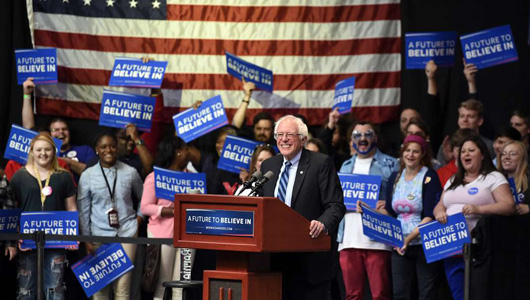
After winning the Indiana Republican presidential primary yesterday, right winger Donald Trump was crowned the “presumptive” nominee by the Republican National Committee. He had trounced Ted Cruz, who dropped out of the race.
The results of the primary have starkly clarified the contours of the 2016 presidential election. The outcome will be determined by how the Democratic and Republican parties address the crisis facing American working people.
Trump was the only Republican contender to win the votes of large numbers of working people angry that their standard of living has plummeted. He blamed foreign governments for taking jobs away from American workers by luring U.S. corporations to their shores. He promised to “bring jobs back to America and keep them here.” He didn’t say how.
To keep Trump out of the White House, Democrats have a choice: They can offer real solutions to the problems confronting workers who might otherwise support Trump. Or in the general election they can concentrate on keeping the votes of the demographic groups that oppose Trump and hope they outnumber his supporters.
The danger of choosing the second option is that Trump has vowed to win enough supporters in the general election to win in states like Pennsylvania, Ohio, Illinois, Indiana, Michigan and Wisconsin; states with large numbers of workers who are fed up with being taken for granted by Democrats. Together, these states have enough votes in the Electoral College to swing a presidential election.
The winner of yesterday’s Indiana Democratic primary, Bernie Sanders, chose the first option (offering solutions to the problems confronting workers who might otherwise support Trump). He reached out to the same workers Trump is trying to woo and he won big in Indiana as a result.
Significantly, Sanders also won the votes of people under 45 in just about every demographic category.
During the campaign leading up to the Indiana primary, Trump had railed time and again against Mexico for taking the Carrier Corporation away from Indiana.
Meanwhile, Sanders rallied with Carrier workers protesting the loss of their jobs. He was endorsed by their union, United Steelworkers Local 1999.
“Bernie Sanders for decades has fought against the kinds of disastrous trade deals that are now allowing Carrier to ship over a thousand good-paying Indiana jobs to Mexico,” said Local 1999 president Chuck Jones.
At the Carrier workers’ rally, Sanders proposed a plan similar to one established by President Obama through an executive order. It encouraged domestic government contractors to raise employees’ wages by mandating preferential treatment for companies that do. Under the Sanders version of the plan, if a corporation such as Carrier wants to do business with the U.S. federal government (like most corporations, it does) it must stay in the U.S. and provide its employees with the pay and benefits needed for a secure future.
Furthermore, Sanders called for the elimination of all tax breaks currently given to corporations who move off shore, and for all corporations to pay their fair share of taxes whether they operate here or abroad.
During their Indiana campaigns, both Sanders and Hillary Clinton pointed out that Trump himself has set up shop in low wage parts of the world. Donald J. Trump Collection shirts – as well as eyeglasses, perfume, cuff links and suits – are made in Bangladesh, China and Honduras.
Trump’s daughter Ivanka, a vice president at his company and frequent campaign surrogate, markets hundreds of additional products under her own line of jewelry and clothing, many of which are made in China.
Hillary Clinton made no speech at the conclusion of the Indiana primary, but it is very clear that despite Sanders’ win, she remains well ahead in the race toward the nomination. Some 2,215 delegates have pledged to vote for her at the Democratic National convention in July, including 513 super delegates, most of whom pledged their support to her even before she or Sanders started campaigning at the beginning of this year.
Sanders has won the support of 1,442 delegates through balloting in primaries and caucuses. So far, 41 super delegates have said they will support him at the National Convention.
It will take the backing of 2,383 delegates to win the nomination.
Stop Trump movement fades
The Stop Trump movement put together by the “establishment” wing of the Republican party apparently hit a brick wall when the Republican National Committee anointed Trump as “presumptive nominee.”
However, there seems to be a few Republicans who are sticking to their own “anybody but Trump” pledge.
For example, Mark Salter, a former top aide to John McCain said yesterday that he will vote for Hillary Clinton.
For the most part, though, even Republicans who literally cursed out Trump in recent weeks are now backing him.
A New York Times editorial said: “Republican leaders have for years failed to think about much of anything beyond winning the next election. Year after year, the party’s candidates promised help for middle-class people who lost their homes, jobs and savings to recession, who lost limbs and well-being to war, and then did next to nothing. That Mr. Trump was able to enthrall voters by promising simply to “Make America Great Again” – but offering only xenophobic, isolationist or fantastical ideas – is testimony to how thoroughly they reject the politicians who betrayed them.
“Republicans haven’t yet begun to grapple with this. Instead they’re falling into line.”
The question is: can the Democratic Party overcome the rage and sense of betrayal many voters have toward all “established” politicians?
Several days ago, the highly regarded Rasmussen organization conducted a national telephone survey of likely U.S. voters and for the first time found that Trump leads Clinton by 41 percent to 39 percent.
Conversely, all polls show Sanders beating Trump by double digits.
Most Democratic Party advisors are encouraging Clinton to stay on the path she has been on and to make Sanders’ policy agenda her own.
It works.
Trump knows it works, too. He recently said on MSNBC that: “Bernie Sanders has a message that’s interesting. I’m going to be taking a lot of the things Bernie said and using them.”
However Trump has proven himself to be a chameleon that will “use things” one minute and discard or contradict them the next. He has demonstrated he has no real commitment except to self-promotion.
Hillary Clinton, on the other hand, has a proven record of public service and a demonstrated ability to work effectively within the U.S. political system. If she embraces the “political revolution” that’s spreading within the Democratic Party rank-and-file and that’s encouraging thousands of younger voters to become activists, Trump and the right wingers won’t have a chance.
Photo: By hitting hard on the harmful effects of trade agreements on U.S. workers Bernie Sanders was able to win the Democratic primary in Indiana yesterday. Progressives are hoping that Hillary Clinton’s campaign will get the message if she becomes the Democartic party’s nominee for the presidency. | Jason Clark/Evansville Courier & Press via AP

MOST POPULAR TODAY


Zionist organizations leading campaign to stop ceasefire resolutions in D.C. area

High Court essentially bans demonstrations, freedom of assembly in Deep South

Afghanistan’s socialist years: The promising future killed off by U.S. imperialism

Communist Karol Cariola elected president of Chile’s legislature






Comments